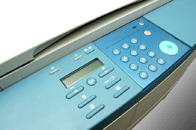Copier Features
Modern copy machines offer a ton of features and options, ranging from production functions such as printing and faxing to sorting,
image editing and even security controls. Many machines are now billed as document centers or “document imaging” machines, which
references their ability to store documents in memory (for future retrieval and access) along with functions such as network
printing that can take modern machines far beyond being “just a copier.”
Most copiers now include automatic document feeders (ADF), which allow users to copy a stack of documents instead of placing them one at a time onto the glass. A re-circulating ADF, used to flip pages around inside the machine, is a good option to consider if you will frequently need to copy lots of double-sided pages.
Sorting and finishing include multiple bins or bin-free sorting (setting documents at right angles to separate them), stapling, folding, three-hole-punches, and more. Some type of sorting system is standard on most machines with higher-end copiers offering more in recognition of larger output, while finishing options such as stapling or hole punching tend to be optional.
In general a copier will include a one or more letter-sized paper supplies, along with other bins in a range of sizes (letter, legal, adjustable) with larger machines including more options and larger bin sizes. Larger paper capacities let you go longer between refills.
Using your Copier as a Printer
Allowing employees to print from their desktop computers directly to your copies will save you money -- the costs per page are lower than laser printers – and means you have one less machine to purchase and maintain. This functionality lets your employees to quickly produce dozens of collated, stapled, high quality documents without leaving their desks. The only downside to using your office copier as a printer is that it creates a single point of failure that can seriously impact your productivity if the machine has a problem.
back to top
Sending and Receiving Faxes
You can purchase a fax module as an option with your machine or later as an add-on; this feature will let you send and receive faxes through your copy machine. Copiers with this ability will either route faxes into the main output bin or into a dedicated fax bin; to send you’ll either scan documents on the copy glass or feed them via your document feeder. Again, the only real potential downside here is losing multiple office functions simultaneously if the copy machine requires service.
back to top
 Image Editing Image Editing
Digital copy machines can allow you to edit documents that have been sent to the machine. Basic examples include automatic re-sizing or rotating to fit selected paper sizes, or reducing multiple images to fit onto one sheet of paper. More involved editing includes adding watermarks, stamps such as “confidential,” page numbers, or even removing borders from tables.
Depending on what your specific needs are, these features can range from invaluable to unused, so it may be worth taking an informal poll of your employees that will access the new copier. Often, users prefer to finish the editing process at their computers and simply hit “print” or
“copy” to create the document.
back to top
Security Systems
Many copiers allow you to require that users enter a security code before making any copies. This serves the two-fold purpose of preventing unauthorized use along with allowing your office to track use of the machine by department or even by user. Some of these machines can also hold documents (copy or print jobs) in memory until a code is provided by a user, which prevents users from leaving confidential documents accessible in the output bins. These security features are more common on larger, more expensive machines, and more popular with larger companies that have greater security and accounting concerns.
back to top
|